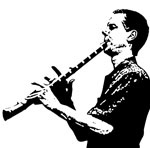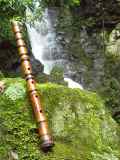Mujitsu and Tairaku's Shakuhachi BBQ
World Shakuhachi Discussion / Go to Live Shakuhachi Chat
You are not logged in.
Tube of delight!
#1 2010-06-12 05:57:01
- Peter Kororo
- Member

- Registered: 2008-06-21
- Posts: 82
- Website
Upcoming inforamtion on doing meri-kari without wrecking your neck
I have been composing an article about one health- or body-related matter; namely, in 2004 right after I returned to the US I had a pretty serious whiplash accident which for about 2 years made it impossible for me to play shakuahchi for more than about 30-45 minutes . Needless to say it was a difficult time (I also couldn't look up for 9 months, that was no fun either), but through a serendipitous meeting I was introduced to an extraordinary practictioner of Rolfing, Sharon Hancoff, who fixed my neck, loosened up my mouth, increased my breathing volume, and did much more. So information on avoiding neck strain while doing lots of meri-kari, as well as getting relief for neck strain, will also be on the website along with links to her practice.
“Many people come, looking, looking. Some people come, see.”
—Nepalese saying
Offline
#2 2010-06-12 12:13:04
- Musgo da Pedra
- Member

- From: South of Brazil
- Registered: 2007-12-02
- Posts: 332
- Website
Re: Upcoming inforamtion on doing meri-kari without wrecking your neck
My sensei always say to practice meri going to both sides, left and right, so you develop the same muscles on every side, in a simetrical way...
Omnia mea mecum porto
Offline
#3 2010-06-12 15:19:48
- radi0gnome
- Member

- From: Kingston NY
- Registered: 2006-12-29
- Posts: 1030
- Website
Re: Upcoming inforamtion on doing meri-kari without wrecking your neck
Musgo da Pedra wrote:
My sensei always say to practice meri going to both sides, left and right, so you develop the same muscles on every side, in a simetrical way...
Is going to the side still called meri?
"Now birds record new harmonie, And trees do whistle melodies;
Now everything that nature breeds, Doth clad itself in pleasant weeds."
~ Thomas Watson - England's Helicon ca 1580
Offline
#4 2010-06-12 16:23:20
- Dun Romin
- Member

- From: Holland
- Registered: 2008-04-19
- Posts: 136
Re: Upcoming inforamtion on doing meri-kari without wrecking your neck
Bowing also a bit to the side for meri is what my teacher thaught me too. Meri is the deepening of the tone. Using the sides gives you the possibility to go deeper with less chance to lose the tone and you practise both sides to learn which side works best for you.
Tomorrow's wind only blows tomorrow. (Koji)
Offline
#5 2010-06-12 17:01:30
- Musgo da Pedra
- Member

- From: South of Brazil
- Registered: 2007-12-02
- Posts: 332
- Website
Re: Upcoming inforamtion on doing meri-kari without wrecking your neck
radi0gnome wrote:
Musgo da Pedra wrote:
My sensei always say to practice meri going to both sides, left and right, so you develop the same muscles on every side, in a simetrical way...
Is going to the side still called meri?
Hi Charles!
For those who know what meri is, its obvious that I meant left down and right down.
If you play at "normal" position and go to the side (left / right ) you will make the pitch go up, since you will be opening the blowing place more, so not meri man!!!
A big hug!
Omnia mea mecum porto
Offline